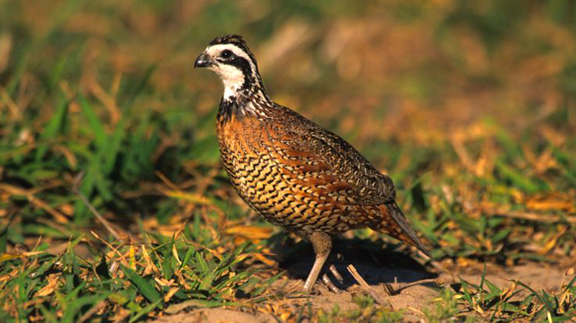Farm & Ranch
National Ranching Heritage Center Hosts Inaugural Quailapalooza

DATE: March 30, 2015
CONTACT: Sue Jones, [email protected]
(806) 834-2646
National Ranching Heritage Center Hosts Inaugural Quailapalooza
With the quail being an important part of the South Plains ecosystem, children will have the opportunity to learn more about this bird.
Children 6-12 years old will have a hands-on opportunity to see how scientists study quail during the inaugural Quailapalooza from 1-3:30 p.m. April 18 at the National Ranching Heritage Center (NRHC) at Texas Tech University.
“For many ranchers, the northern bobwhite quail is a treasured rangeland inhabitant,” said Brad Dabbert, a Texas Tech University professor of natural resources management who will share his knowledge with some of the area’s youngest students. “Unfortunately, bobwhite populations are declining throughout their historic range in Texas.”
The NRHC will partner with the Department of Natural Resources Management at Texas Tech to host a hands-on educational presentation for children focusing on Northern Bobwhite Quail and the science behind studying this ecology.
Dabbert and Texas Tech graduate students will give participants the opportunity to see live adult quail and chicks, learn about thermal cameras and radiotelemetry, observe a quail nest and eggs, learn what quail eat and how scientists capture them, and see how scientists use cameras to study bobwhites and quail predators.
The program is free to NRHC Junior Roughriders and $5 for non-members. Limited space is available. To register for the event, contact NRHC Director of Educational Programs Julie Hodges at (806) 742-0498 or [email protected].
Supported by the Ranching Heritage Association and Texas Tech, the NRHC is a unique 27-acre museum and historical park offering educational programs and exhibits to promote interest in ranching history and contemporary ranching issues. Located at 3121 4th St., the center provides 49 authentic dwellings and ranch structures from some of the nation’s most historic ranches.
Find Texas Tech news, experts and story ideas at Texas Tech Today Media Resources or follow us on Twitter.
CONTACT: Julie Hodges, director of education programs, National Ranching Heritage Center, Texas Tech University, (806) 742-0498 or [email protected]
Farm & Ranch
Acorn Toxicity

By Barry Whitworth, DVM, MPH
With the prolonged drought, most pastures in Oklahoma end up in poor condition. With the lack of available forage, animals may go in search of alternative foods.
If oak trees are in the pastures, acorns may be a favorite meal for some livestock in the fall. This may result in oak poisoning.
Oak leaves, twigs, buds, and acorns may be toxic to some animals when consumed.
To read more, pick up a copy of the November edition of North Texas Farm & Ranch magazine, available digitally and in print. To subscribe by mail, call 940-872-5922.

Farm & Ranch
Silver Bluestems

By: Tony Dean
There are a handful of grasses on North Texas grazing lands ranchers need to know, not because they are highly desirable, but rather because they are not of much value. I call them “decom” plants, which is am acronym for “Don’t Ever Count On Me.” Silver bluestem is a “decom” grass.
Silver bluestem is a perennial which grows in all areas of Texas. It can survive in almost all soil types, and in full sun conditions or in semi shade. It grows up to three feet tall and is easily recognized with the presence of the white fuzzy seed head. Also, one of the identifying characteristics of Silver bluestem is a bend in the stems at each node, causing the plants to take on a rounded shape as they mature.
To read more, pick up a copy of the November edition of North Texas Farm & Ranch magazine, available digitally and in print. To subscribe by mail, call 940-872-5922.

Farm & Ranch
Meanwhile Back At The Ranch

By: Rayford Pullen
Fall is here which means winter is closing in on us and before we officially get into winter, we need to make sure our factories are either producing or will be producing in a few months.
We have been pregnancy testing our cows this fall and if they are not bred or nursing a calf, we are bidding them adios. With annual costs somewhere between $900.00 and $1,000.00 per cow, those cows not producing a live weaned calf are costing us quite a bit.
To read more, pick up a copy of the November edition of North Texas Farm & Ranch magazine, available digitally and in print. To subscribe by mail, call 940-872-5922.
-

 Country Lifestyles2 years ago
Country Lifestyles2 years agoScott & Stacey Schumacher: A Growth Mindset
-

 Country Lifestyles8 years ago
Country Lifestyles8 years agoStyle Your Profile – What your style cowboy hat says about you and new trends in 2017
-

 HOME8 years ago
HOME8 years agoGrazing North Texas – Wilman Lovegrass
-

 Equine1 year ago
Equine1 year agoThe Will to Win
-

 Country Lifestyles5 years ago
Country Lifestyles5 years agoAmber Crawford, Breakaway Roper
-

 Outdoor9 years ago
Outdoor9 years agoButtercup or Primrose?
-

 Country Lifestyles8 years ago
Country Lifestyles8 years agoJune 2016 Profile – The man behind the mic: Bob Tallman
-

 Country Lifestyles8 years ago
Country Lifestyles8 years agoDecember 2016 Profile, Rusty Riddle – The Riddle Way




